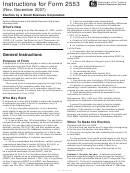Instructions For Form 2553 - Election By A Small Business Corporation
ADVERTISEMENT
Instructions for Form 2553
Department of the Treasury
Internal Revenue Service
(Rev. December 2017)
Election by a Small Business Corporation
Section references are to the Internal Revenue Code unless
Regulations section 1.1361-1(m). For guidance on how to
otherwise noted.
convert a QSST to an ESBT, see Regulations section
1.1361-1(j)(12). If these elections weren’t timely made, see
Future Developments
Rev. Proc. 2013-30, 2013-36 I.R.B. 173, available at
IRS.gov/irb/2013-36_IRB#RP-2013-30.
For the latest information about developments related to
Form 2553 and its instructions, such as legislation enacted
4. It has no nonresident alien shareholders.
after they were published, go to IRS.gov/Form2553.
5. It has only one class of stock (disregarding differences
Reminder
in voting rights). Generally, a corporation is treated as having
only one class of stock if all outstanding shares of the
Simplified methods for a corporation (entity) to request relief
corporation's stock confer identical rights to distribution and
for a late S corporation election, ESBT election, QSST
liquidation proceeds. See Regulations section 1.1361-1(l) for
election, or corporate classification election are in effect. See
details.
Relief for Late
Elections.
6. It isn’t one of the following ineligible corporations.
a. A bank or thrift institution that uses the reserve method
General Instructions
of accounting for bad debts under section 585.
b. An insurance company subject to tax under
Purpose of Form
subchapter L of the Code.
c. A corporation that has elected to be treated as a
A corporation or other entity eligible to elect to be treated as
possessions corporation under section 936.
a corporation must use Form 2553 to make an election under
d. A domestic international sales corporation (DISC) or
section 1362(a) to be an S corporation. An entity eligible to
former DISC.
elect to be treated as a corporation that meets certain tests
discussed below will be treated as a corporation as of the
7. It has or will adopt or change to one of the following tax
effective date of the S corporation election and doesn’t need
years.
to file Form 8832, Entity Classification Election.
a. A tax year ending December 31.
The income of an S corporation generally is taxed to the
b. A natural business year.
shareholders of the corporation rather than to the corporation
c. An ownership tax year.
itself. However, an S corporation may still owe tax on certain
d. A tax year elected under section 444.
income. For details, see Tax and Payments in the
Instructions for Form 1120S, U.S. Income Tax Return for an
e. A 52-53-week tax year ending with reference to a year
S Corporation.
listed above.
Who May Elect
f. Any other tax year (including a 52-53-week tax year)
for which the corporation establishes a business purpose.
A corporation or other entity eligible to elect to be treated as
For details on making a section 444 election or requesting
a corporation may elect to be an S corporation only if it meets
a natural business, ownership, or other business purpose tax
all the following tests.
year, see the instructions for Part II.
1. It is (a) a domestic corporation, or (b) a domestic entity
8. Each shareholder consents as explained in the
eligible to elect to be treated as a corporation, that timely files
instructions for column K.
Form 2553 and meets all the other tests listed below. If Form
2553 isn’t timely filed, see
Relief for Late
Elections, later.
See sections 1361, 1362, and 1378, and their related
2. It has no more than 100 shareholders. You can treat
regulations for additional information on the above tests.
an individual and his or her spouse (and their estates) as one
A parent S corporation can elect to treat an eligible wholly
shareholder for this test. You can also treat all members of a
owned subsidiary as a qualified subchapter S subsidiary. If
family (as defined in section 1361(c)(1)(B)) and their estates
the election is made, the subsidiary's assets, liabilities, and
as one shareholder for this test. For additional situations in
items of income, deduction, and credit generally are treated
which certain entities will be treated as members of a family,
as those of the parent. For details, see Form 8869, Qualified
see Regulations section 1.1361-1(e)(3)(ii). All others are
Subchapter S Subsidiary Election.
treated as separate shareholders. For details, see section
When To Make the Election
1361(c)(1).
3. Its only shareholders are individuals, estates, exempt
Complete and file Form 2553:
organizations described in section 401(a) or 501(c)(3), or
No more than 2 months and 15 days after the beginning of
certain trusts described in section 1361(c)(2)(A).
the tax year the election is to take effect, or
For information about the section 1361(d)(2) election to be
At any time during the tax year preceding the tax year it is
a qualified subchapter S trust (QSST), see the instructions
to take effect.
for Part III. For information about the section 1361(e)(3)
For this purpose, the 2-month period begins on the day of
election to be an electing small business trust (ESBT), see
the month the tax year begins and ends with the close of the
Dec 02, 2017
Cat. No. 49978N
ADVERTISEMENT
0 votes
Related Articles
Related forms
Related Categories
Parent category: Financial
 1
1 2
2 3
3 4
4 5
5 6
6








